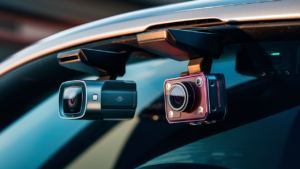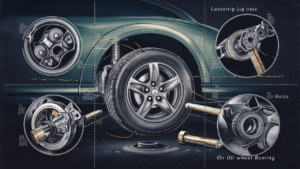Have you ever wondered if you can play your guitar through studio monitors? Maybe you’re looking for a clearer, more accurate sound while practicing or recording.
Using studio monitors might seem like a great idea, but is it really the best choice for your guitar? You’ll discover how studio monitors work with guitars, the benefits and potential issues, and tips to get the best sound possible.
Keep reading to find out if this setup can take your playing to the next level.
Guitar And Studio Monitor Basics
Playing guitar through studio monitors requires understanding some basics. Studio monitors differ from regular speakers. They show the true sound of your guitar without adding color. This helps you hear every detail clearly. Knowing how monitors work and your guitar’s signal helps you get the best sound.
Below are some key points about studio monitors and guitar signals. This knowledge sets a strong base for using monitors with your guitar.
How Studio Monitors Work
Studio monitors are designed to give flat, clear sound. They do not boost bass or treble. This way, you hear the real audio, not a changed version. Monitors usually have two drivers: a woofer for low sounds and a tweeter for high sounds. They need to be placed carefully for the best sound.
Types Of Studio Monitors
There are two main types: active and passive monitors. Active monitors have built-in amplifiers. Passive monitors need an external amplifier. Active monitors are easier to use and common in small studios. Passive ones offer flexibility but need more gear. Both types vary in size and power.
Guitar Signal Characteristics
Guitar signals are different from other instruments. Electric guitars send low-level, unbalanced signals. These need to be boosted before reaching monitors. Guitar signals can be clean or distorted. Distortion changes the signal shape and adds harmonics. Understanding this helps you connect and adjust your gear properly.
Connecting Guitar To Studio Monitors
Playing guitar through studio monitors can give you clear and detailed sound. It helps you hear every note and tone properly. Connecting your guitar directly to monitors needs some care. The right setup improves your practice and recording experience.
This section explains how to connect your guitar to studio monitors. It covers common challenges and useful tools to make the process smooth.
Direct Connection Challenges
Plugging your guitar straight into studio monitors often causes problems. Guitars have weak signal outputs compared to other audio devices. Monitors need a line-level signal to work well. A direct connection can cause low volume and poor sound quality. Also, the tone may sound thin or distorted. This setup usually lacks the warmth and richness of a proper amp or interface.
Using Audio Interfaces
Audio interfaces solve many connection problems. They boost your guitar’s signal to the right level. Interfaces convert your guitar’s analog signal into a digital format. This process improves sound clarity and strength. Most interfaces connect easily to computers and monitors. Some include built-in effects and amp simulations. This feature allows you to shape your sound without extra gear.
Role Of Amplifiers And Di Boxes
Amplifiers add power and tone shaping to your guitar signal. They give your sound body and character before it reaches the monitors. Direct Injection (DI) boxes help match your guitar signal to the monitor input. DI boxes reduce noise and signal loss during connection. Using an amp or DI box ensures a cleaner and richer sound. These tools are key for high-quality guitar playback through studio monitors.
Optimizing Sound Quality
Optimizing sound quality is key when playing guitar through studio monitors. Good sound helps you hear every detail and improve your playing. Small changes can make a big difference in your listening experience.
Adjusting Monitor Settings
Start by checking your monitor’s volume level. Keep it moderate to avoid distortion. Use the bass and treble controls to balance the sound. Reduce bass if it sounds boomy or unclear. Raise treble for more clarity and brightness.
Some monitors have room correction features. Use these to match the sound to your room. Turn off any extra effects on the monitors. This keeps the sound clean and natural.
Using Effects And Amps Plugins
Plugins add tone and character to your guitar sound. Choose amp simulators for a wide range of tones. Play with distortion, reverb, and delay effects to shape your sound.
Use plugins inside your recording software. This gives you control over every sound detail. Avoid too many effects at once. Keep your guitar tone clear and focused.
Positioning Monitors For Best Sound
Place your monitors at ear level for the best sound. Form an equilateral triangle with your listening position. This means the monitors and your head are equal distances apart.
Keep monitors away from walls and corners. This reduces unwanted echoes and bass buildup. Angle them slightly towards your ears. This helps you hear the guitar sound accurately.
Common Issues And Solutions
Playing guitar through studio monitors can bring your sound to life. Still, some common problems may arise. These issues affect sound quality and gear safety. Understanding these problems helps you fix them fast. Here are key problems and easy solutions.
Dealing With Noise And Distortion
Noise and distortion often come from bad connections or wrong settings. Check all cables for damage or loose plugs. Use good-quality shielded cables to reduce interference. Keep your volume at a moderate level to avoid distortion. If distortion continues, adjust your guitar or amp settings. Sometimes, changing the input level on your audio interface helps too.
Latency Problems
Latency causes a delay between playing and hearing sound. This delay can make playing feel off. Lower your audio buffer size in the software to reduce latency. Use a direct monitoring feature if your audio interface offers it. Avoid running many programs at once to keep your computer fast. A faster computer or audio interface can also help.
Protecting Monitors From Damage
Studio monitors can get damaged by loud sounds or power surges. Keep the volume at a safe level to protect speakers. Avoid sudden loud noises like feedback or clipping. Place monitors on stable stands or pads to reduce vibrations. Use a surge protector to guard against power spikes. Turn off monitors when not in use to extend their life.
Alternatives To Studio Monitors
Studio monitors are great, but they are not the only option for playing guitar. Many musicians find other tools better fit their needs. These alternatives can offer unique sounds and practical benefits. They suit different environments and budgets. Exploring them can improve your music experience.
Using Guitar Amps
Guitar amps are designed to shape your guitar’s tone. They add warmth and character that studio monitors lack. Playing through an amp gives you a natural feel and response. Many amps come with built-in effects, boosting creativity. They also deliver louder sound, perfect for live play or practice.
Employing Headphones
Headphones offer privacy and detail. You hear every note clearly, even in noisy places. They are easy to carry and use anywhere. Headphones reduce sound spill, making them good for late-night sessions. Some models simulate amp sounds, adding realism to your playing.
Hybrid Monitoring Setups
Hybrid setups mix monitors, amps, and headphones. This approach gives you the best of all worlds. You can switch between devices to match the moment. It helps you catch different sound details during practice or recording. Hybrid systems offer flexibility and control over your tone.

Frequently Asked Questions
Can I Connect My Guitar Directly To Studio Monitors?
Yes, you can connect your guitar to studio monitors using an audio interface or DI box. This setup ensures clear, balanced sound and protects your equipment from damage.
Are Studio Monitors Good For Guitar Practice?
Studio monitors provide accurate sound reproduction, making them ideal for guitar practice. They help you hear details and improve your playing quality effectively.
Do Studio Monitors Amplify Guitar Sound Well?
Studio monitors accurately reproduce guitar sound but don’t amplify it like guitar amps. Use an audio interface with proper gain settings for best results.
What Equipment Is Needed To Play Guitar Through Monitors?
You’ll need an audio interface or DI box to connect your guitar to studio monitors. Additionally, use cables and possibly amp simulation software for optimal sound.
Conclusion
Playing guitar through studio monitors can work well for practice and recording. These monitors give clear, detailed sound to hear every note. You need the right cables and gear for the best connection. Keep volume at a safe level to avoid damage.
Studio monitors help you mix and hear your guitar sound better. Not perfect for live shows but great in a home studio. Try it out and see how your music improves. Simple setup, clear sound, and better control over your guitar tone.








